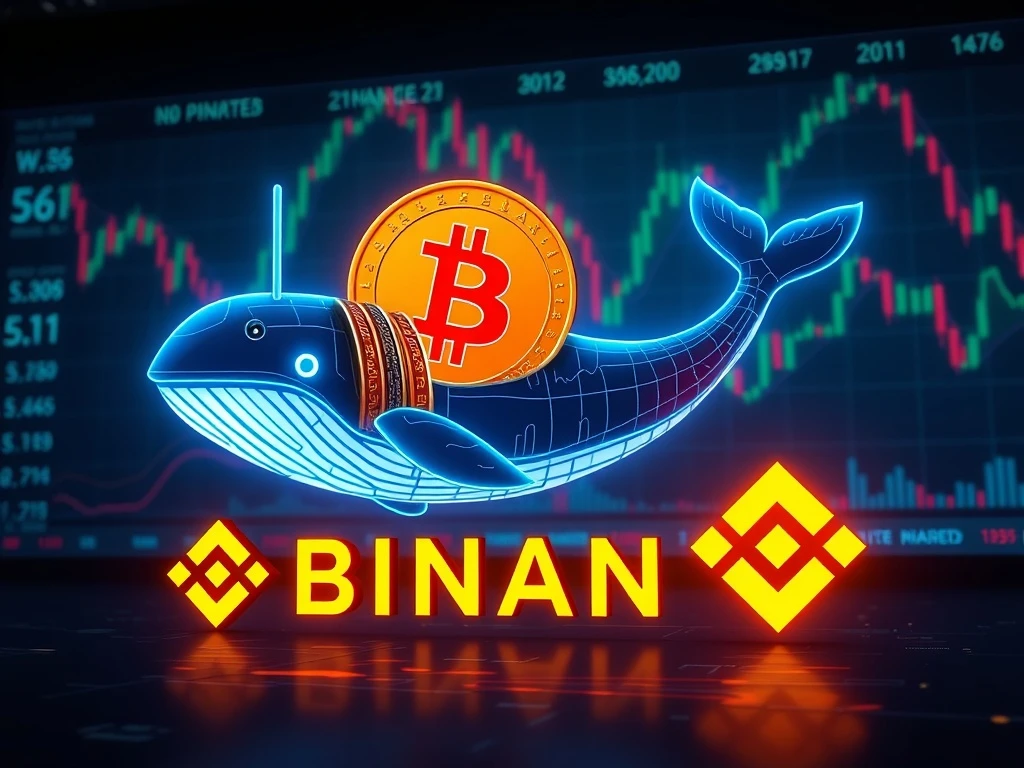Crucial WBTC Deposit: Anonymous Crypto Whale’s Binance Move Sparks Market Impact Fears

The cryptocurrency world is always buzzing with activity, and few events capture attention quite like the movements of a massive crypto whale. Recently, the digital waves rippled significantly as an anonymous whale made a substantial WBTC deposit to Binance, sparking intense speculation across the market. This isn’t just another transaction; it’s a strategic maneuver that could hint at shifts in sentiment, liquidity, and even price action. Understanding these large-scale moves is crucial for anyone navigating the volatile waters of crypto.
Understanding the Strategic WBTC Deposit
On July 28, 2025, an anonymous crypto whale initiated a significant transaction, depositing 50 Wrapped Bitcoin (WBTC) to the prominent exchange, Binance. This move immediately triggered discussions among analysts and traders, primarily focusing on the potential for profit-taking and its broader implications for the market. But what exactly makes this WBTC deposit so noteworthy?
- Scale of the Transaction: 50 WBTC, equivalent to millions of dollars, is a substantial amount. Such large deposits by individual entities, often referred to as ‘whales,’ are rare and indicative of strategic intent.
- Anonymous Nature: The identity of the whale remains unknown, adding an element of mystery and increasing the scrutiny of their actions. Their address, 0x3E3…1140C, has a history of executing large-scale trades.
- Previous Activity: This isn’t the whale’s first rodeo. On-chain analyst @ai_9684xtpa previously noted a withdrawal of 101.33 WBTC (valued at $11.98 million at the time) from Binance by the same address. This pattern suggests a calculated approach to market cycles, involving both accumulation and distribution.
The Crypto Whale’s Clever Strategy: Flash Loans and Accumulation
One of the most intriguing aspects of this crypto whale‘s activity is the reported use of a flash loan strategy to accumulate WBTC. Flash loans are a unique DeFi primitive that allows users to borrow large sums of uncollateralized capital, provided the loan is repaid within the same blockchain transaction. Here’s how it likely played out for this whale:
The whale utilized a flash loan to acquire WBTC at an average price of $69,162. This suggests a sophisticated understanding of DeFi mechanics and market timing. Flash loans are often employed for arbitrage opportunities, collateral swaps, or, as in this case, potentially to acquire assets for a short period before moving them to an exchange. The fact that the whale then deposited this WBTC to Binance indicates a likely intention to sell or reallocate assets.
Why Use a Flash Loan for Accumulation?
- Capital Efficiency: Flash loans allow access to significant capital without needing to lock up personal collateral, making large-scale acquisitions highly capital-efficient.
- Speed: The entire operation occurs within a single transaction block, minimizing market exposure time and execution risk.
- Strategic Positioning: By acquiring WBTC at a specific price point, the whale positioned themselves to potentially realize gains if the market moved favorably, or to rebalance their portfolio under specific conditions.
Binance’s Role: Liquidity and Trading Dynamics
The choice of Binance as the destination for this WBTC deposit is significant. As one of the world’s largest cryptocurrency exchanges, Binance possesses deep liquidity pools, making it an ideal venue for large-scale transactions without causing excessive price slippage. However, an influx of 50 WBTC can still have notable effects:
- Increased Available Supply: The deposit immediately increases the available supply of WBTC on Binance. This can influence the order book, potentially making it easier for buyers to acquire WBTC at current prices, or for sellers to offload their holdings.
- Altered Trading Dynamics: Higher liquidity might lead to heightened trading volumes for WBTC. Traders closely monitor such events, anticipating potential shifts in price action. If the whale decides to sell, it could add selling pressure, while if they are simply rebalancing, the impact might be less direct.
- Price Benchmarking: Should the deposited WBTC be liquidated or actively traded, it could influence the price benchmarks for WBTC, especially if the whale’s actions trigger a cascade of follow-on trades from other market participants.
Market participants are now closely watching Binance’s WBTC order books and trading activity to gauge the immediate effects of this significant deposit.
Unpacking the Broader Market Impact
The ripple effects of such a substantial WBTC deposit extend far beyond just Binance’s order book. Large whale activity often serves as a leading indicator of investor sentiment and can precede significant price shifts across the broader cryptocurrency landscape. This market impact can manifest in several ways:
Potential for Increased Volatility
When a whale makes a move of this magnitude, it injects uncertainty into the market. Traders and algorithms react to these signals, which can amplify short-term volatility in WBTC and other correlated crypto assets. The market tries to interpret the whale’s intentions: is it a precursor to a large sell-off, or merely a portfolio rebalancing?
Shifts in Supply-Demand Dynamics
The influx of assets onto an exchange like Binance reshapes the immediate supply-demand balance. If the whale intends to sell, it increases supply, which, absent a corresponding increase in demand, could exert downward pressure on prices. Conversely, if the deposit is part of a larger strategy involving different assets, the overall market impact might be more nuanced.
Investor Sentiment and Follow-on Trades
Whale movements are closely scrutinized because they often reflect the sentiment of large, informed players. If other traders perceive the deposit as a bearish signal (e.g., anticipating a dump), they might pre-emptively sell their own holdings, creating a cascading effect. Conversely, if the deposit is interpreted as a strategic repositioning for future gains, it might inspire confidence.
Is It Just Profit-Taking, or Something More?
The prevailing narrative surrounding this WBTC deposit leans heavily towards profit-taking. Given the whale’s reported accumulation price of $69,162, any current price above that level would represent a gain. However, the term ‘profit-taking’ itself is neutral and doesn’t inherently signal bullish or bearish sentiment.
Different Interpretations of Profit-Taking:
- Strategic Exit: The whale might be locking in gains on a portion of their holdings, perhaps due to reaching a price target or anticipating a market downturn.
- Capital Reallocation: Instead of exiting the market entirely, the whale might be converting WBTC into another asset (e.g., stablecoins, altcoins) to pursue new opportunities or manage risk. This would still be considered profit-taking from the WBTC position.
- Liquidity Provision: Less likely for such a large amount, but theoretically, the whale could be providing liquidity to a specific trading pair on Binance, though this usually involves more active market making.
Without additional context about the whale’s broader long-term strategy, it’s challenging to draw definitive conclusions. However, the timing of the transaction, following a prior accumulation phase, certainly aligns with objectives of capitalizing on price fluctuations.
Actionable Insights for Traders and Investors
For those navigating the crypto markets, whale activity offers valuable, albeit indirect, insights. Here’s how you can use this information:
- Monitor On-Chain Data: Tools that track whale movements and exchange flows can provide early signals. While not always predictive, they offer a glimpse into the actions of major players.
- Assess Liquidity: Understand how large deposits affect exchange liquidity. Increased liquidity can mean less price impact for large trades, but also potentially more competition for orders.
- Consider Volatility: Be prepared for potential short-term volatility around such events. Large deposits can create buying or selling pressure that impacts prices.
- Don’t Blindly Follow: While whale movements are important, they are only one piece of the puzzle. Combine this information with your own technical and fundamental analysis. The whale’s strategy might not align with your risk profile or investment goals.
Conclusion: The Ongoing Saga of Whale Watchers
The recent WBTC deposit by an anonymous crypto whale to Binance serves as a potent reminder of the intricate dynamics within the cryptocurrency market. Whether driven by pure profit-taking or a more complex strategic reallocation, the event underscores the profound market impact that large players can wield. As the crypto community continues to track the whale’s address for further activity, the interplay between on-chain data and exchange-based liquidity remains a critical focal point for understanding short-term crypto asset trends. These movements highlight the continuous need for vigilance and informed decision-making in this ever-evolving digital financial landscape.
Frequently Asked Questions (FAQs)
Q1: What is WBTC, and why is it important in this context?
WBTC, or Wrapped Bitcoin, is an ERC-20 token that represents Bitcoin on the Ethereum blockchain. It allows Bitcoin holders to participate in Ethereum’s decentralized finance (DeFi) ecosystem, including lending, borrowing, and yield farming. In this context, the whale’s WBTC deposit to Binance suggests they are moving their Bitcoin-backed assets from the DeFi space to a centralized exchange, possibly for selling or trading purposes.
Q2: How do crypto whales typically impact the market?
Crypto whales are individuals or entities holding a large amount of cryptocurrency. Their large transactions can significantly impact market sentiment, liquidity, and price volatility. When whales deposit large amounts to exchanges, it can signal potential selling pressure, while large withdrawals might indicate accumulation or a move to self-custody. Their actions are closely watched as they can sometimes precede significant price movements.
Q3: What are flash loans, and how did the whale use them?
Flash loans are a unique, uncollateralized lending mechanism in DeFi where users can borrow assets without providing collateral, provided the loan is repaid within the same blockchain transaction. The anonymous whale reportedly used a flash loan to acquire 50 WBTC at an average price of $69,162. This suggests they leveraged this DeFi tool for capital efficiency and speed to acquire the assets before moving them to Binance, likely for a subsequent trade or sale.
Q4: Does a large WBTC deposit to Binance always mean a price dump?
Not necessarily. While a large deposit can increase the available supply on an exchange and potentially lead to selling pressure, it doesn’t automatically guarantee a price dump. The whale might be reallocating capital, moving assets for security, or preparing for a different strategic trade. The actual impact depends on broader market conditions, the whale’s ultimate intent, and how other market participants react to the increased liquidity.
Q5: How can everyday traders track whale movements?
Everyday traders can track whale movements through various on-chain analytics platforms and blockchain explorers. Tools like Whale Alert, Arkham Intelligence, Lookonchain, and Etherscan allow users to monitor large transactions, identify whale addresses, and observe their historical activity. Following reputable on-chain analysts on social media can also provide timely insights into significant whale moves.








